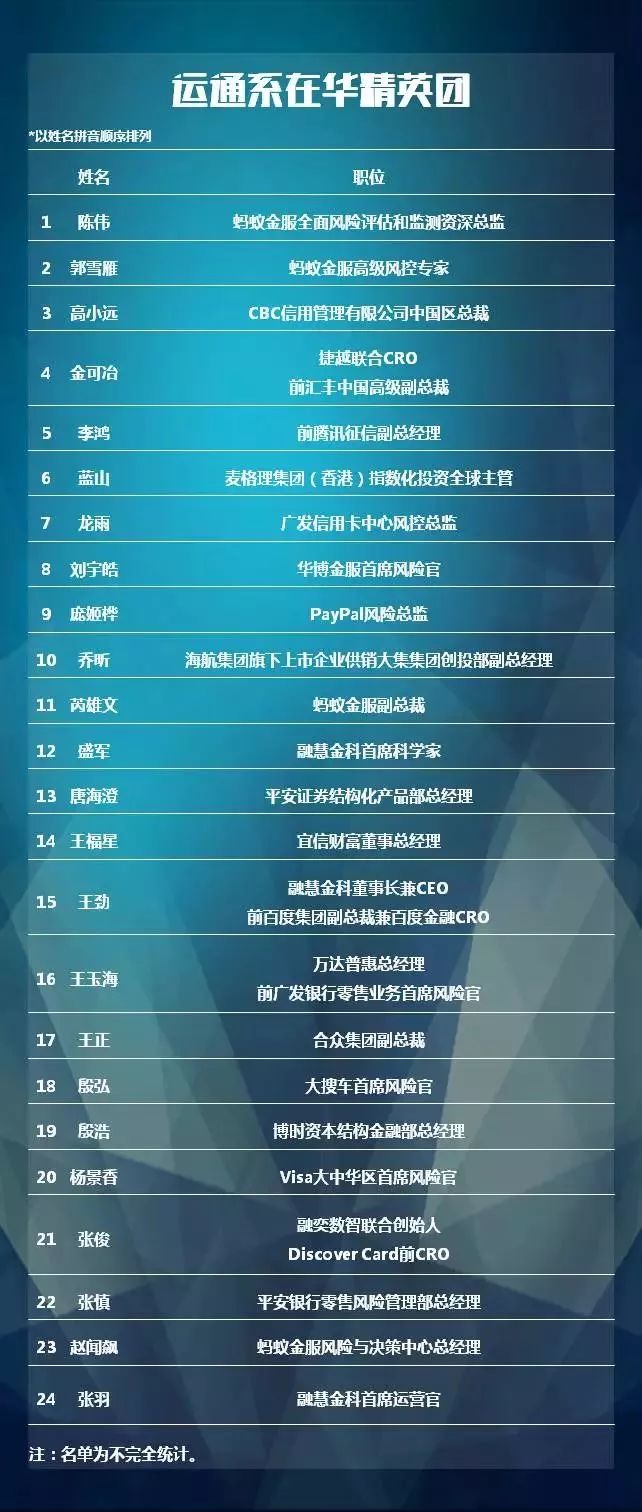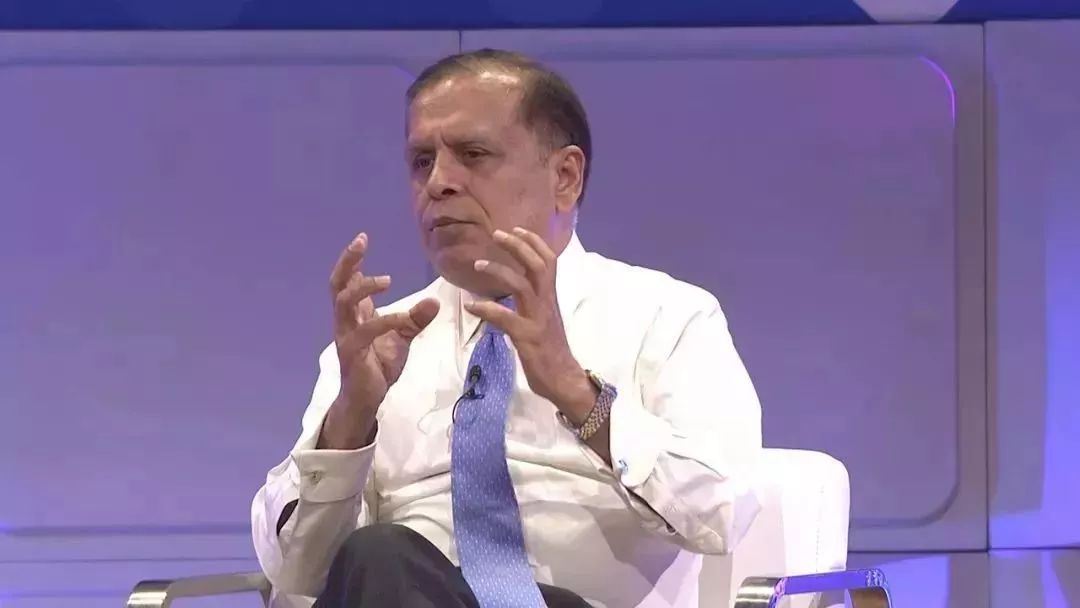(英文版)金融圈的“隐秘大佬”:掌舵BAT金融,把控银行核心,却低调神秘
2018年04月08日 18:10:21
来源:一本财经
原标题:(英文版)金融圈的“隐秘大佬”:掌舵BAT金融,把控银行核心,却低调神秘 点击关注一本财经,
原标题:(英文版)金融圈的“隐秘大佬”:掌舵BAT金融,把控银行核心,却低调神秘
点击关注一本财经,置顶公众号
金融科技领域第一新媒体,不容错过
━━━━━━
原文:金融圈的“隐秘大佬”:掌舵BAT金融,把控银行核心,却低调神秘
THE FINANCIAL CIRCLE'S "HIDDEN LEADERS": AT THE HELM OF BAT FINANCE, HEADING THE BANKING CORE WHILE MAINTAINING LOW PROFILES

By Russell
In China's financial circle, there are a group of low-profile but powerful leaders. They are discreet, rarely making appearances in the media.
However, these leaders almost control the financial departments of BAT (Baidu, Alibaba, and Tencent). In addition, they are also at the top tier of traditional financial institutions as heads of risk management.
Compared with those from Capital One, the “first financial circle gang”, most of these low-profile yet powerful leaders returned to China at a later time; fewer in number, but holding higher positions upon their return. Perhaps because of this, in the eyes of the outside world, they hold less star power and have attracted less media attention.
They have a common background: all originated from American Express.
01 Elite Background
In recent years, more than 30 elites have resigned from a single U.S. company. Their number is small, but after returning to China they mostly occupy critical leadership roles.
Amongst them, some entered large enterprises and controlled the core of BAT's risk management. For example: Jing Wang, former Corporate Vice President of Baidu and CRO of Baidu Financial Services; Xiongwen Rui, Vice President of Ant Financial; Wenbiao Zhao, General Manager of Risk & Decision Center at Ant Financial; Hong Li, former Senior Risk Management Director at Tencent.
Far more than only influencing the internet giants, they also control risk management at traditional financial institutions and at multinational banks. For instance, Keye Jin, former Senior Vice President of HSBC China; Shen Zhang, General Manager of Retail Risk Management at Ping An Bank; Yuhai Wang, General Manager of Wanda Pratt & Whitney; Jingxiang Yang, Chief Risk Officer of Visa Greater China, etc.

In the media, one would rarely encounter this group. Sighting them at a venue, they will be reticent, only occasionally offering a few words, which are always held in high regard. According to external perspectives, these secretive and low-key elites are becoming the core pillar of China's risk management industry.
This group of mysterious leaders all have a common mark: they all came from a magical company – American Express.
The first key word that comes to mind when people think of "American Express" is "premium". And its iconic representative is undoubtedly the Centurion card.
This is an invitation-only card recognized as the "King of Cards”, representing top status. All kinds of myths and legends exist about the Centurion card—that for example, it can make airplanes turn around, and trains stop.
In reality, the personal services that Centurion card members can enjoy are truly the best in the world:
After the 2004 tsunami disaster, Hong Kong card member asked for help in rescuing friends stranded on the island. American Express immediately sent cash and airplane seats to the latter.
There was a card member who ran out of gas in the Sahara desert and the car rental company refused to come to the rescue. American Express sent a helicopter through the Moroccan military to rescue it.
......
"Today, we still firmly stand by the original American Express core values of honesty and integrity, and strive for excellence," former American Express CEO Ken Chenault said. Behind this proud statement stood the test of 168 years.
What is perhaps unexpected is that when American Express was founded in 1850, in New York, it was just an ordinary freight company. At the moment of its founding, the United States was in a rapid growth period, had built a 10,000-mile railway, and the western development was in full swing.
Following this, American Express weathered the two World Wars, passed through the Great Depression of the 1930s, and continued to grow.
It issued the world's first traveler's check, followed by the world's first platinum card.
Warren Buffett has held its stock since the 1960s.
Today, American Express is one of the world's largest financial services company with a global transaction volume of 1 trillion US dollars, total assets of 158.9 billion U.S. dollars, and a division in more than 20 countries, with more than 56,000 employees.

It is also the world’s largest independent credit card company. The Centurion card and co-brand cards are world-renowned and 110 million cards are used throughout the world.
In 2018, American Express ranked 14th among Fortune's World's Most Admired 50 Companies.
There are few companies that have survived from the same era of its founding. It is as such a well-established and respectable financial company that has created this strong group of highly qualified leaders.
02 Leaders
More than two decades ago, Chinese employees began to join American Express.
At that time, employees who had originated from China were almost all from ordinary families. They started from scratch and worked hard in their new foreign country. American Express became their first employer. Here, they remained for more than 10 years.

△ From left to right are: Hong Li, former Senior Risk Management Director at Tencent; Jing Wang, Chairman of the Board and CEO at Fintell Financial Services/former Corporate Vice President of Baidu; Yuhai Wang, General Manager of Wanda Pratt & Whitne/former CRO of Retail Business of Guangfa Bank; Keye Jin, CRO of Jieyue United/former Senior Vice President of HSBC China; Wenbiao Zhao, General Manager of Risk & Decision Center at Ant Financial
After joining Risk Management at American Express, Hong Li was surprised that his colleagues brought a wide variety of educational backgrounds: transportation management, social sciences, biology, statistics, physics...etc.
But these colleagues shared important common characteristics: they showed strong logical thinking and data analytic skills, were curious about new things, and had leadership potential.
"Being able to identify the most essential elements within complexity." Keye Jin summed up one of the core criteria for talent recruitment.
American Express developed them into being leaders.
“We would encourage employees to do all things, and also encourage them to look further while doing something,” said Keye Jin.
Some strategies included letting new people rotate; encouraging cross-functional sharing and learning; organizing various internal trainings allowing employees to participate in industry exchanges.
They had numerous opportunities to sharpen their own skillsets. Once they mastered certain positions, they would be able to move on to new fields.
Hong Li has worked in the United States, Singapore, India and Thailand.
Keye Jin also worked in three geographies: Canada, Hong Kong, and the United States.
Wenxuan Zhao and Jing Wang have had 6 and 7 positions respectively in the United States.
American Express from time to time also required them to do work that was outside to their core responsibilities, inclusive of campus recruitment, employee engagement, and community service. These were also included in performance assessments.
Employees are treated as family members rather than cogs, and great emphasis is placed on personal development.
"American Express gave us a sense of belonging." Hong Li said.
"American Express was respectful to every employee, whether you are Vietnamese, Chinese, or Indian. And the company was full of a great atmosphere." Jing Wang said.
It is in such a dynamic environment that this group of leaders had continued to develop and grow, experiencing a number of roles, and being tempered by different geographies, gradually becoming an elite in their own right.
03 Brand Management
The impact of American Express on them extends to far more than just its culture. Almost all the people in the game have mastered one of the critical keys to the success of American Express: card member benefits.

This is precisely the most neglected point in the financial technology industry in China.
“Now everyone is thinking about increasing volume to acquire new customers, but are not paying attention to the management of existing customers. In fact, it is this population that is the real goldmine.” Jing Wang said.
American Express leverages this goldmine to the extreme. Since the launch of the charge card, American Express has positioned the premium segment as a focal target group.
For these customers, American Express has built world-class membership rewards. Holding a premium American Express card is almost a symbol of elite identity.
Jing Wang illustrates the privileges that customers can enjoy:
At a thousand five-star hotels around the world they can enjoy room upgrades;
Enjoy the VIP lounges of dozens of airlines at the airport and take opportunities to upgrade for free;
Platinum card members are allowed a free international business class companion ticket. The annual fee for such a card is $500, and the ticket price for an international flight far exceeds this figure.
Jing Wang believes that the value to the card member is far more than that. More importantly is the emotional connection.
For example, rewards can send card members and their families to travel with Disney; to send bouquets of flowers at the most important moments in the card members’ lives. This gives the emotional impression to card members: even my significant other does not remember these moments. Only American Express remembers.
The famous American Express Centurion Card is specially designed for high-end users. Card members enjoy top privileges and personal concierge services, allowing them to feel like royalty.
Keye Jin has retained a Centurion card with a tail number of 88888: a souvenir of his participation in the issuance of the HongKong Black Card during his time as the Chief Credit Officer of JAPA.

△Keye Jin’s Hong Kong Centurion Card Launch Souvenir
This is the first Centurion card issued in the JAPA region. "Within the first day of launching, we received 10,000 calls from customers asking how they could get this card."
Hong Kong has a clear social hierarchy. The attractiveness of the Centurion card is that it can offer access to certain elite clubs, to which not even money could buy membership. Another attractive point is that there is no limit on spend.
The card member benefits are not only privileged and emotionally connected, but also embedded with privacy protection.
At American Express, the position of “Privacy Officer” was established very early on, and access to customer data would be highly restricted.
Politically sensitive card members can take comfort in that American Express pays special attention to its customer privacy protections and compliance across the board.
"For example, during a country's coup, we knew the whereabouts of people of interest earlier than the media or the authorities, but we wouldn't divulge secrets, and strictly managed the accounts in accordance with anti-money laundering and other regulations," said Hong Li.
Perhaps a hallmark of a truly good product is not only that which constantly acquires new customers, but also one that continues to extend the life cycle of its existing customers. And it is this very vitality that allows American Express to continue for more than a hundred years. This is the secret of a century-old financial institution.
04 Risk Management Principles
When he first joined American Express, working on the 47th floor of company headquarters in New York, Jing Wang met one person in the hallway: someone who often walked slowly, seeming to be in contemplation. This person was Ash Gupta, who at that time, was the chairman of the American Express Credit Risk Management Committee.
Ash Gupta later became Chief Risk Officer and President of Risk & Information Management at American Express.
During his 41 years tenure at American Express, as the heart and soul figure of risk management, Ash lead the team to build a best-in-class risk management system, helping American Express become a worldwide leader in leveraging data to drive innovation.

△ Ash Gupta is the heart and soul of risk management
How important was Risk Management to American Express back then?
The Risk Management team is involved throughout the entire product life cycle, as a critical decision maker.
The company invests heavily in the training of risk-management talent. When Hong Li was in office, all new Risk Management employees must all fly to New York for a week-long training.
A great impact on American Express employee life is Ash Gupta's advanced Risk Management principles. In the second year of Jing Wang’s tenure, Ash Gupta delivered the Risk Management mission at the Risk Management employee town hall. He said three things:
"First, to drive profitable growth. Second, to avoid surprises. Third, to provide an outstanding customer experience."
"I was very surprised at that time. How should risk management emphasize customer experience and drive business growth? Isn't that against the nature of risk control?" recalls Jing Wang.
In general, risk management is generally considered a brake rather than an accelerator. Driving business growth is considered a core responsibility of the marketing department. Inside a company, the Risk Management department and the Marketing department are often foils to each other.
From Ash Gupta's mind, Risk Management and Marketing are not in conflict, not water and fire, but can instead be blended together in collaboration.
In addition, it is conventionally believed that risk management’s role o say “No” to risky customers— a rejection that serves as a shield, which impacts the customer experience.
Risk Management leaders now must take the customer's point of view to understand whether the product is customer-friendly, rather than just considering the issue from the perspective of traditional risk management.
"I later came to understand that real risk management is to be integrated with all of the company's departments rather than as a silo function. This is a more superior mission of risk management." Jing Wang said.
Ash Gupta, with an educational background in engineering, focuses greatly on data and systematic controls. As early as in the 1980s, American Express began data-driven risk management and was a pioneer in this field.
“In my mind, in the traditional financial institutions in the United States, American Express was the first to propose using big data for risk management.” Hong Li recalled that the company also invited young experts from Silicon Valley to lecture at New York headquarters. The lecturer wore denim and the attendees came in suits, but all took it seriously.
Only through a complete economic cycle can a company's risk management ability be ultimately validated.
At an American Express quarterly town hall, Ash Gupta pointed out that there was a bug in US home mortgage loans. It was around 2004, still four years away from the outbreak of the subprime mortgage crisis. The U.S. economy was booming. At this time, Ash Gupta discovered the hidden dangers of prosperity.
He repeatedly reminded the team to be wary of risk.
At the end of 2007, Wenbiao Zhao sensed a dangerous atmosphere—the delinquency rate of credit card and mortgages rose rapidly.
The subprime mortgage crisis had arrived.
In the storm, Lehman Brothers and other giants fell, and the American Express also faced a test of life and death.
Small businesses had become major victims in the subprime mortgage crisis.
At this time, Jing Wang was currently working at the Small Business Services Department. He looked at the bad debt rate curve, which had climbed from below 5%, straight to more than 10%.
"There was a sense that the world was ending." He recalled the fear at that time and wondered what would happen next.
After a long period of financial crisis, Jing Wang got to know that the danger at that time went far beyond his imagination. “Actually, at the most difficult time, the cash on our book was not enough for a month.” The CEO mentioned during a meeting at a later time. Between life and death, there was often only a thin line. The financial industry had never been completely safe and has always been watchful.
Ash Gupta also underwent pressure: because of the higher growth and lower risk prior to the crisis, American Express’s risk indexes seemed to increase more than those of other companies. Cutting budgets, adjusting product mix, tightening credit lines, innovating models, and optimizing collection strategies— Ash Gupta took all steps.
American Express properly handled the crisis, and the government began to offer support. In the end, the liquidity risk of American Express was controlled and the difficulties were overcome. With painstaking experience, after the subprime mortgage crisis ended, American Express strengthened the Global Risk Management Oversight function and established an automated early warning system.
The lessons learned for Risk Management leadership at American Express was: good Risk Management is not only developed for a good economy but also considers worst cases (e.g. black swan events).
"We started to emphasize more on stress tests and to prepare for the worst when making decisions," said Jing Wang.
After the financial crisis, the status of Risk Management has been elevated in both American Express and the entire US financial community. The CRO not only reports to the CEO, but also reports to the Risk Committee of the Board of Directors. Under such a system, "CRO can counterbalance the CEO and influence the company's direction to the greatest extent."
It is precisely because of the financial crisis that Risk Management at American Express became stronger and gained more respect.
05 Returing to China
Because of work and family reasons, Chinese people often come and go between China and the United States.
In the early 21st century, China’s financial industry still lagged behind the United States.
"If the United States at that time could score 90 points, then China would score 40 or 50 points," said Keye Jin.
The pioneers felt the temptation from the enormous opportunities in China.
Keye Jin decided to return home. He first arrived at HSBC China as a senior vice president and then joined Jieyue United.
In 2004, when Hong Li returned to China to visit his relatives, it coincided at a time that the United States tightened visa restrictions for China. He could not return to the United States and stayed in Beijing for three months.
"At the time I thought it was too absurd! Why can’t I just stay in my own country?"
A year later, he applied for transfer to American Express Singapore – which is closer to China.
At this time in China, the payment industry had just sprung to life. Unexpectedly, this gave China an opportunity to get ahead of the curve, bypassing the credit card stage of the United States directly and entering the “time of cashless payment”.
And it is this rise of payments that sowed the seeds of China’s financial technology.
The talents in American Express are undoubtedly the best talents for China.
They have multinational experience, having rotated among developed and developing countries. They have been given autonomy in managing their responsibilities.
For the Chinese leaders who have risen to senior positions at American Express, it can be difficult for them to take the step to go back to China.
"There were about 15 Chinese leaders in the rank of vice president and above at American Express," said Jing Wan, who was Senior Vice President of American Express. His wife is also a vice president there.
A similar list is long: Keye Jin, Chief Credit Officer of American Express JAPA; Wenbiao Zhao, Vice President of American Express; Hong Li, Director of Risk Management for Global Network Services JAPA; Yuhai Wang, Director of Risk Management.
"Why are so few Chinese who would move back? Because their 'glass ceiling' is quite high," said Jing Wang.
At this time in China, the fire of financial technology was already showing signs of being kindled. "Currently, it is a golden age for China's consumer finance, and this era will continue for a long time." - This view has gradually become those leaders’ consensus.
At this point, more and more people have finally started their journey back home.
In 2010, Yuhai Wang accepted the invitation of Guangfa Bank to return to China, led the team, and successfully introduced American Express' risk management tools.
In 2014, Hong Li accepted Tencent's invitation to return to China to develop the Tencent credit information system and payment risk management system. He leveraged the experience of American Express and reduced the rate of fraudulent funds loss to below one millionth.
In 2015, Jing Wang joined Baidu to build an end-to-end risk management system, focusing on payment fraud and customer level risk management
And they will also be transporting the culture and essence of American Express to China. For instance, Jing Wang adopted Ash’s three-prone Risk Management mission to lead Baidu Financial Services. The concept and system of customer benefits, Hong Li and Jing Wang also strongly advocated in their own companies.
American Express leaders are feeling the rapid rise of China’s financial technology. They experience China getting ahead of the curve and find that the prospects are endless.
"Returning to China is a right decision." Almost each of the returning executives expressed such feelings. Those who have already taken up their posts still maintain a low profile and simplicity.
They have become the “hidden leaders” behind the wave of financial innovation.
他们的故事和理念还没看够?
4月21日,一本财经将在北京举行第二届“风控·命门”金融科技风控峰会,文中的运通系多位风控大佬都将来到现场。
除此之外,Capital One、美国发现金融、渣打银行、花旗银行等海外一线金融机构会齐聚一堂;中国风控杰出的银行,如平安、招商、广发等银行的风控精英们,也将悉数到场,分享风控技术,破解风控难题,把握风控趋势。
对风险,永葆敬畏之心。
扫描下图二维码立即报名




- 好文

- 钦佩

- 喜欢

- 泪奔

- 可爱

- 思考


凤凰网科技官方微信
视频
-

李咏珍贵私人照曝光:24岁结婚照甜蜜青涩
播放数:145391
-

金庸去世享年94岁,三版“小龙女”李若彤刘亦菲陈妍希悼念
播放数:3277
-

章泽天棒球写真旧照曝光 穿清华校服肤白貌美嫩出水
播放数:143449
-

老年痴呆男子走失10天 在离家1公里工地与工人同住
播放数:165128





















